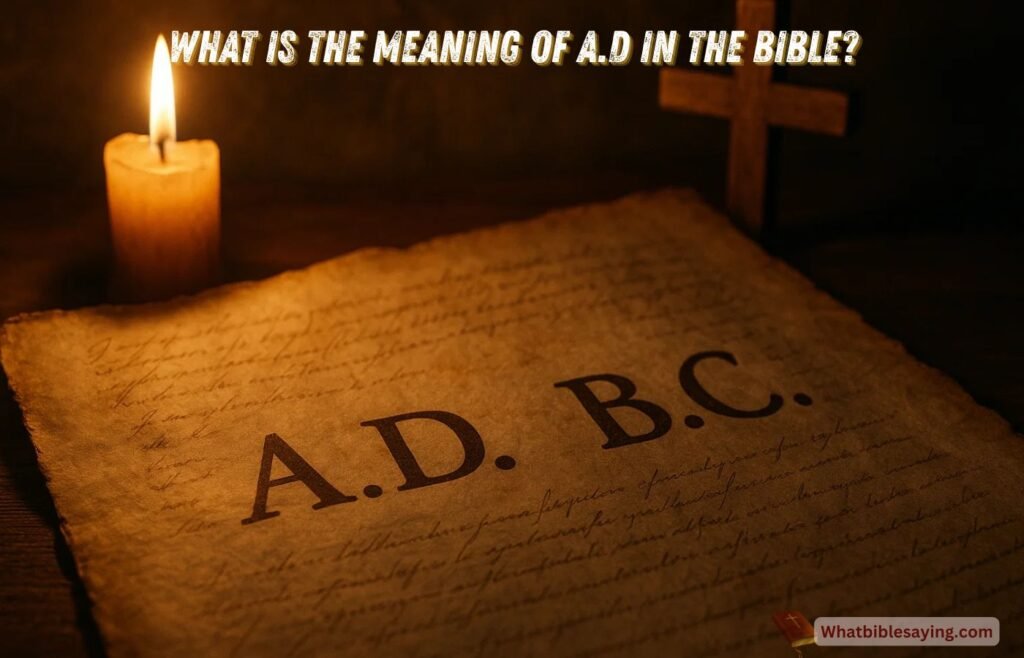 When you open a history book or glance at a timeline, you’ve probably seen dates like 320 A.D. or 33 A.D. They look like simple markers of time, but behind those two letters — A.D. — lies a story that connects history, faith, and the life of Jesus Christ.
When you open a history book or glance at a timeline, you’ve probably seen dates like 320 A.D. or 33 A.D. They look like simple markers of time, but behind those two letters — A.D. — lies a story that connects history, faith, and the life of Jesus Christ.
Today, we’re going to explore what A.D. means in the Bible, how it relates to B.C., and why this little abbreviation still carries such deep meaning for Christians around the world.
A.D. — More Than Just Two Letters
The letters A.D. stand for the Latin phrase Anno Domini, which means “in the year of our Lord.” This system of dating is tied directly to the birth of Jesus Christ. When you see “A.D. 2025,” it literally means “the year of our Lord 2025” — 2,025 years after Jesus’ birth.
In contrast, the letters B.C. stand for “Before Christ.” So when you see “320 B.C.,” it means 320 years before Jesus was born. Together, B.C. and A.D. split all of human history into two great eras: before Christ came, and after He was born.
This isn’t just a calendar trick — it’s a declaration that Jesus Christ is the center of history.
What Do BC and AD Stand For?
B.C. = Before Christ
A.D. = Anno Domini (Latin for “in the year of our Lord”)
These terms have been used for centuries to help people understand time in relation to the coming of Christ. Every time we write a date — whether 33 A.D. for the crucifixion or 2025 A.D. for today — we’re reminded that the life of Jesus is the very hinge of history.
Some modern historians now use B.C.E. (Before Common Era) and C.E. (Common Era) instead. But at their core, they still reference the same turning point: the birth of Jesus. The world cannot escape that history is divided because of Him.
The Full Meaning of A.D.
You may have heard people say that A.D. means “After Death.” That’s a common mistake. Imagine how confusing that would be — where would the years of Jesus’ life fit?
The correct full meaning is “Anno Domini” — in the year of our Lord. That phrase acknowledges that after Jesus entered the world, all time became measured in relation to Him.
So when the Bible says in Galatians 4:4, “But when the fullness of time had come, God sent forth his Son,” we see that Christ’s arrival wasn’t random. Even the way we count years points back to Him.
What Does A.D. Mean in Biblical Terms?
While the Bible itself doesn’t use the abbreviation A.D., the concept fits perfectly with Scripture. The prophets of the Old Testament looked forward to the coming of the Messiah. Their world was “B.C.” — before Christ.
When Jesus was born in Bethlehem, as told in Matthew 1:18–25 and Luke 2:1–20, history turned a corner. The “fullness of time” had arrived. From then on, every year could be counted as “in the year of our Lord.”
That’s why dates like “33 A.D.” carry so much weight. Most Christians believe Jesus died and rose again around that year. So A.D. doesn’t just mark time — it marks the reign of Christ, the Lord of time itself.
What Does “320 A.D.” Mean?
Let’s take an example: 320 A.D.
“320” is the year number.
“A.D.” tells us that it’s 320 years after the birth of Jesus Christ.
So 320 A.D. was a time when the early church was growing rapidly. In fact, the Roman Empire had just legalized Christianity under Emperor Constantine, and Christians were no longer being hunted for their faith.
That one abbreviation — A.D. — ties a simple date to a powerful story of God at work in history.
Why Does the World Use A.D. and B.C.?
The system of B.C. and A.D. was first popularized in the 6th century by a monk named Dionysius Exiguus. He wanted to calculate the dates of Easter and began counting years from the birth of Jesus. Over time, this dating system spread across Europe and eventually around the world.
Think about that: even people who don’t believe in Jesus still live by a calendar centered on Him. Every time someone writes “2025,” they are — knowingly or not — acknowledging the life of Christ.
How Does A.D. Connect to the Bible?
The Bible reminds us again and again that Jesus is the center of God’s plan.
In Revelation 1:8, Jesus says, “I am the Alpha and the Omega, who is and who was and who is to come, the Almighty.”
Hebrews 13:8 declares, “Jesus Christ is the same yesterday and today and forever.”
So when we use A.D., we’re not just using a historical system. We’re echoing the truth that Christ is Lord over all time.
A.D. and Your Daily Life
Now, you might be thinking: That’s interesting history, but what does it mean for me?
Here’s the truth: Every day you live is an “A.D.” day. Every sunrise you see, every breath you take, every moment of your life is “in the year of our Lord.”
That means your time is not wasted. It belongs to Him. Psalm 31:15 says, “My times are in your hands.” Knowing that Christ is the Lord of history should remind us that He is also the Lord of our personal story.
Lessons We Can Take From A.D.
Christ is the center of history.
The whole timeline of the world pivots on His birth.Christ is the Lord of time.
He holds yesterday, today, and tomorrow in His hands.Christ is personal.
Every year you live is “in the year of our Lord.” That means your story is written into His story.
Clearing Up Misunderstandings About A.D.
Does A.D. mean after death?
No. It means “in the year of our Lord.”Is A.D. in the Bible?
The abbreviation itself is not, but the concept — that history is divided at Christ’s coming — is deeply biblical.Why does the world still use it?
Because Jesus’ life is the central turning point of history, recognized even in secular culture.
Bringing It Home
I still remember talking with a young student who once asked me, “Pastor, why do my history books say A.D.? What does it have to do with Jesus?”
That simple question gave me a chance to tell him that every single year — from the first Christmas night until today — is stamped with the truth that Christ has come.
Friend, when you see A.D. on the page, don’t just think of it as a cold piece of history. Think of it as a reminder that God stepped into time, walked among us, and gave us eternal hope through His Son.
Conclusion
So, what is the meaning of A.D. in the Bible?
It means Anno Domini — in the year of our Lord. It’s a reminder that Jesus is the center of all history and the Lord of every moment of our lives.
The next time you write today’s date, pause and whisper a prayer of thanks: “Lord, thank You that I live in the year of Your grace.”
Because whether it’s 33 A.D., 320 A.D., or 2025 A.D., every year belongs to Him.











